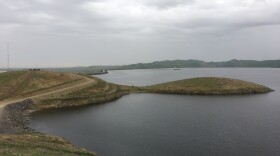As of July 10 manual snow surveyors reported there’s zero snow left in the mountains above the San Joaquin River. But a new way to measure the snowpack from the sky is showing a different set of results.
"The snow depths there were exceeding 30 feet in depth with drifts of snow that were greater than 60 feet on the face and spanning 400-500 feet wide." - Jeffrey Payne, Friant Water Authority
“Already we’re seeing snowmelt 50 percent greater than it was last year and about 320 percent above what the observations were for 2014.” says Jeffrey Payne with the Friant Water Authority.
At the peak of the snow season there was around 2.4 million acre feet of water in the San Joaquin River watershed. Payne knows this because of a new project with NASAwhere planes rigged with lasers flyover the area to detect things like snow density.
“We’re already three weeks longer than last year and there’s still another 200,000 acre feet up in the measured snowpack, which is eight percent of the peak that still remains in snow,” says Payne. “At the end of April we saw large patches of snow on the leeward side of the ridge on the northern side of the San Joaquin. The snow depths there were exceeding 30 feet in depth with drifts of snow that were greater than 60 feet on the face and spanning 400-500 feet wide.”
Payne says the flyovers on the San Joaquin are also informing water entities like his about how fast snow is melting based on its albedo. He says, the darker snow is the faster it melts because darker colors reflect solar energy less than brighter colors.
"This year we've seen a noticeably dusty snowpack with very low albedo... making the snow melt much quicker than it has in the past." - Jeffrey Payne, Friant Water Authority
“This year we’ve seen a noticeably dusty snowpack with very low albedo… making the snow melt much quicker than it has in the past,” Pays says. “The NASA team has yet to analyze snow albedo for 2017, but we’re expecting they’re going to conclude that the darkening of the snow in this late portion of the season is changing the runoff pattern. We can potentially expect future years to have different runoff patterns depending on how dusty the snow is.”
The new data is also helping better inform other watersheds in the region. Payne says when the Kings River was dealing with flooding in June, officials overseeing that watershed were able to look at the data from the San Joaquin in order to make better decisions about how full to keep reservoirs like Pine Flat Dam.
“I don’t want to overstate this, but we might have seen some lessened damage from the Kings River flooding in June of this year because of the flyover surveys,” say Payne. “The Kings and the San Joaquin are sister rivers. They have similar hydrology and while the surveys were not conducted for the Kings the survey results from the San Joaquin did make DWR go back and adjust their forecasts. The Army Corps immediately increased the amount of releases at Pine Flat in advance of the high inflows that ultimately exceeded reservoir capacity and overflowed banks on the Kings.”
Payne says seven basins along the Sierra Nevada are now using the tech because of its precision.
In flyovers of the Tuolumne River Basin, where this technology was tested prior to the San Joaquin, “the peak combined snow for 2013 to 2016 was only 90 percent of what we saw in 2017,” Payne says. “If we had the same measurements going on in the San Joaquin for that duration we’d probably be reporting the same.”






